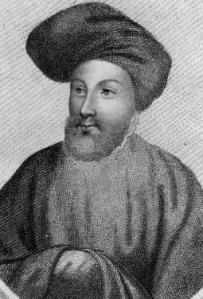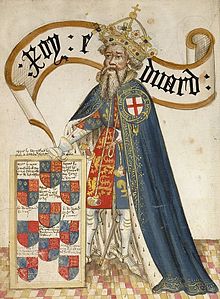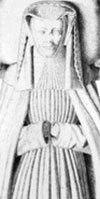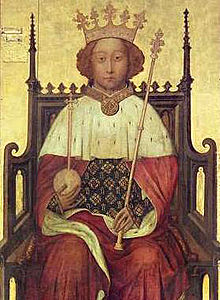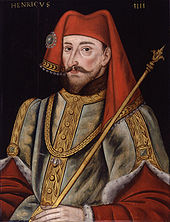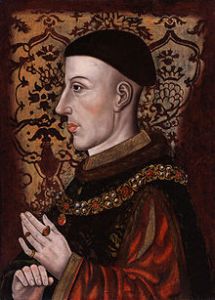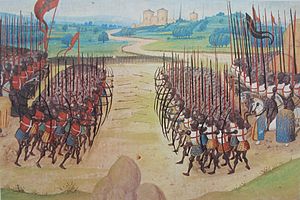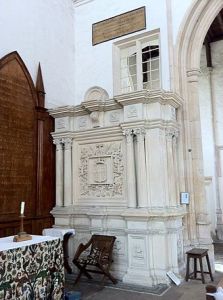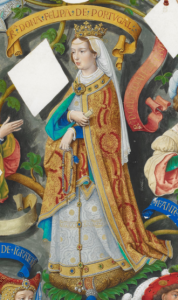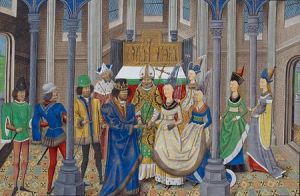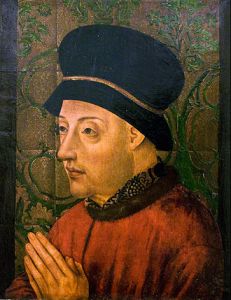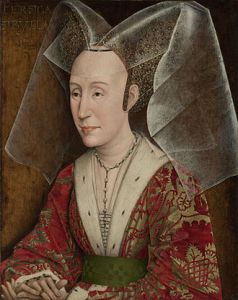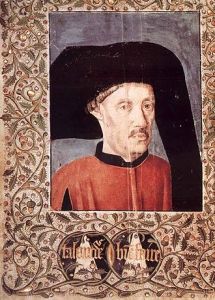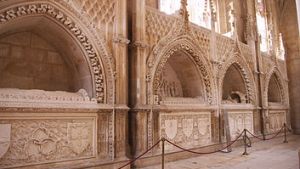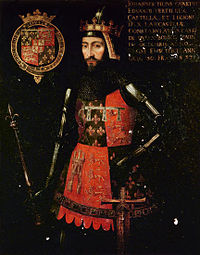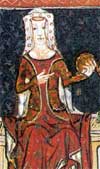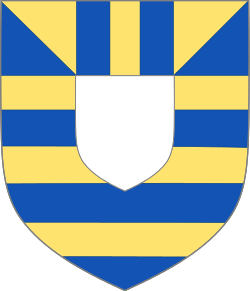Although they had the same start in life, the two daughters of John of Gaunt and Blanche of Lancaster led very different lives as adults. While Philippa would become the mother of the Illustrious Generation of Portuguese princes, Elizabeth would have to overcome scandal and the taint of treason before finding love in the last of her three marriages.
Philippa of Lancaster was born at Leicester on 31 March 1360. She was the eldest daughter of John of Gaunt, Duke of Lancaster and 4th son of Edward III, and his first wife Blanche of Lancaster, great-great-granddaughter of Henry III. Philippa’s father was one of the richest men in the country – and one of the most powerful. Her life as a child would have been one of luxury and privilege, with a glorious dynastic marriage awaiting her in the future. Philippa was raised alongside her younger sister, Elizabeth, who was born in 1363/4, and her baby brother, Henry of Bolingbroke, born in 1367.
The children lost their mother when Blanche died at Tutbury on 12 September 1368, from the complications following the birth a daughter, Isabella, who did not survive. The children’s father was with Blanche when she died but departed on campaign to France soon after; although it is doubtful the children’s care was interrupted.
Philippa and her sister were raised together in one household, with Blanche Swynford, the daughter of their mother’s lady-in-waiting, Katherine Swynford. John of Gaunt provided his daughters with an annual allowance of £200. The Lancaster household was well-organised and run by Katherine, now the girls’ governess. She became mistress to their father, John of Gaunt, in early 1371. Despite his relationship with Katherine, in September 1371 the Lancaster children gained a stepmother in their father’s new bride, Constance of Castile. Constance was the daughter and heir of Pedro the Cruel, the deceased King of Castile who had been murdered by his half-brother, Henry of Trastámara, in March 1369. A new sister arrived when Constance gave birth to Catherine (Catalina) of Lancaster, in 1372/3.
Despite several dynastic marriage propositions, by 1385 and at 25 years old Philippa was still unmarried. However, in the following year her father took all three of his daughters on his military expedition to Spain, hoping to claim the kingdom of Castile in right of his second wife, Constance. Philippa’s marriage to John – or Joao – I of Portugal was agreed as part of an alliance made with her father at Ponte do Mouro in November 1386. Philippa was married to King John at Oporto on 2nd February 1387, before they had even received the required papal dispensation. Philippa was 26 – about 10 years older than the average age for a princess to marry. John of Portugal was three years her senior and had been king for just short of two years.
Almost immediately after the wedding John returned to the war. In July 1387 Philippa miscarried their first child while visiting John at Curval, where he lay seriously ill. However, after what appears to have been a bumpy start, the couple seem to have been well-matched. John had had two illegitimate children before his marriage, but was demonstrably faithful to Philippa after the wedding. In fact, when court gossip reached the queen with rumours that he had been unfaithful, John went to great lengths to convince Philippa of his innocence. He even went so far as to commemorate the event by having a room in the royal apartments at Sintra decorated with chattering magpies as reference to the court gossips.
Philippa became known as ‘Dona Fillipa’ in Portugal and would be one of the country’s best-loved queens. Her natural disposition to austerity and piety was endearing to the Portuguese people. Philippa reformed the court and encouraged courtly games among her ladies. French poet Eustace Deschamps characterised her as the chief patron of the order of The Flower of England, casting her at the centre of the court and the May Day celebrations.
Instrumental in fostering links between England and Portugal, Philippa had been made a Lady of the Garter in 1378. She was on good terms with both Richard II and his successor – her brother, Henry IV. In 1399 she wrote to the Archbishop of Canterbury, Thomas Arundel, asking him to intervene with Henry on behalf of her friend, Bishop Henry Despenser of Norwich, who had angered the new king by defending Richard II at the time of Henry’s invasion of England and seizure of the throne. Philippa also had a hand in persuading Henry to arrange the marriage of her stepdaughter, Beatriz (John’s illegitimate daughter) to the earl of Arundel in 1405.
Philippa and John were to have a large family, which they brought up with great care. Of their 9 children, five sons and a daughter survived infancy and would later be known in Portugal as ‘the Illustrious Generation’ (a Ínclita Geração).
Their eldest surviving son, Edward, was born in 1391 and would succeed his father as King of Portugal in 1433. Peter, Duke of Coimbra, was born in 1392 and would act as regent for his nephew, Afonso V, following Edward’s death in 1438. Their most famous son was Prince Henry ‘the Navigator’, Duke of Viseu, who was renowned for financing and researching great explorations. Another son was John, Duke of Beja and Constable of Portugal, who married Isabella, the daughter of Alfonso I, Duke of Braganza. And the baby of the family was Ferdinand, Grand Master of Aviz. He was born in 1402 and was later known as ‘the Saint Prince’ following his death as a prisoner of the Moors. John and Philippa’s one daughter, Isabella, was born in 1397 and would go on to marry Philip III the Good, Duke of Burgundy; she was the mother of Charles the Bold, Duke of Burgundy.
By 1415 Philippa’s oldest sons were itching to prove their martial prowess. Scorning their father’s offer to hold a magnificent tournament for them, they persuaded him to mount an attack on the port of Ceuta in North Africa. It was as they were about to set sail that Philippa fell ill with the plague. She died at Odivelas, near Lisbon, on 18/19 July 1415, aged 55. On her deathbed she gave her three eldest sons a jewel encrusted sword, each, in anticipation of their impending knighthoods. She also gave them a piece of the true cross and her blessing for the forthcoming military expedition, exhorting “them to preserve their faith and to fulfil the duties of their rank”.
Described as pious, charitable, affable and obedient to her husband, Queen Philippa was held up as a model queen. She was buried in the Dominican Priory at Batalha Abbey, which had been founded by King John, who would be laid beside her after his death in August 1433. Their sons, Ferdinand, John, Henry and Peter, were laid to rest along the south side of the same chapel.
Philippa’s sister, Elizabeth, was not to have such a glittering international marriage. She was also made a Lady of the Garter in 1378 and, in 1380, when she was seventeen years old, her future appeared to be decided when she married John Hastings, Earl of Pembroke, at Kenilworth Castle. However, the young Earl was only about seven years old at the time, being Elizabeth’s junior by ten years, and the princess soon tired of waiting for her bridegroom to grow up. The unconsummated marriage was eventually dissolved around the same time that it was discovered that Elizabeth was pregnant by Sir John Holland, half-brother of Elizabeth’s cousin, King Richard II. John already had a bit of a reputation and was rumoured to have been having an affair with Elizabeth’s aunt, Isabella of Castile, wife of Edmund, Duke of York, and there was a possibility that he was the father of Isabella’s youngest son, Richard of Conisbrough.
Whether Elizabeth was seduced by John Holland, or whether they fell in love, we cannot be certain. However, once the affair was discovered, Elizabeth and Holland were hurriedly married, near Plymouth, on 24 June 1386. Within two weeks, the couple were aboard ship with John of Gaunt, his wife Constance, and daughters, Philippa and Catherine; ninety ships and thousands of men were taking part in an expedition aimed at winning the throne of Castile for Constance and John. Elizabeth gave birth to her daughter Constance, in early 1387. She would have been nursing the infant throughout the disastrous campaign in Castile, which saw the army decimated by a combination of sickness, the unfriendly climate and dwindling supplies. By May 1387, John of Gaunt and his ally, John I of Portugal, the husband of Elizabeth’s older sister Philippa since February, had agreed peace terms with Castile.
At the end of May 1387, Elizabeth, her husband and their baby girl left the army and returned to English soil, after receiving a safe-conduct to travel through Castile. On 2 June 1388 John was created Earl of Huntingdon by his half-brother, the king; he would be elevated to Duke of Exeter on 29 September 1397.
The marriage produced at least four children, three sons and a daughter. Constance, the oldest, married Thomas Mowbray, 4th Earl of Norfolk. Of the sons John, Richard and Edward, John eventually succeeded to his father’s title of Duke of Exeter. The late 1390s proved turbulent times for Elizabeth. Her brother Henry of Bolingbroke was banished from England by their cousin, Richard II, in 1398; the sentence was extended to life following the death of their father, John of Gaunt, on 3 February 1399. When Henry retaliated by invading England and taking the king prisoner, it must have been a difficult time for Elizabeth. Her brother was now King Henry IV, but she was married to the former king’s half-brother.
Her youngest son, Edward was not yet a year old when John Holland joined the conspiracy to restore his brother to the throne, the Epiphany Rising. Holland and his fellow conspirators, the earls of Salisbury, Kent and others, planned to kill the usurping king and his sons at the New Year jousts. However, Henry IV learned of the plot and the conspirators were arrested. John Holland was executed at Pleshey Castle on 9 January 1400, his head placed on London Bridge and his body buried in the Collegiate Church at Pleshey. He was attainted by parliament, his honours and lands forfeit to the crown. However, Elizabeth, as sister of the king, would not suffer for her husband’s treason, and was granted 1,000 marks a year for her maintenance. John and Elizabeth’s eldest surviving son, John, would eventually become Duke of Exeter, in a new creation, in 1444.
Within months of John Holland’s execution, it seems that Elizabeth, now in her late thirties, had an experience that few medieval women were ever privileged to. She fell head over heels in love with Sir John Cornwall, after watching him defeat a French knight in a joust at York. Cornwall was a career soldier who had fought in Scotland and Brittany, and would soon be fighting to defeat Owain Glyn Dwr’s revolt in Wales. Although considerably younger than Elizabeth, he also fell for the Lancastrian princess and within months the couple were secretly married. When he discovered the marriage, the king had Cornwall arrested and thrown into the Tower of London. However, Cornwall’s considerable charm, and most likely the pleas from his sister, soon persuaded the king to release the knight and restore him to favour. A widely respected soldier and one of the great chivalric heroes of his day, Cornwall was accepted into the Order of the Garter in 1409 and was one of Henry V’s most formidable captains during the Agincourt campaign of 1415.
The couple were to have two children – a daughter, Constance and a son, John, who was born before 15 February 1405, when King Henry IV stood as his godfather. Young John would come to a tragic end in 1421, when the teenager was killed at the Siege of Meaux, his father a devastated witness to the tragedy. Elizabeth died at her husband’s estate of Burford, in Shropshire, on 24 November 1425. She was buried in Burford Parish Church, where her magnificent effigy, showing a tall, slender princess in colourful robes, can still be seen today. Sir John Cornwall was created Baron Fanhope in 1432 and Baron Milbroke around 1441; he died at his great estate of Ampthill in Bedfordshire on 11 December 1443 and was buried in a chapel he had founded, in the cemetery of the Friars Preacher near Ludgate in London. His two children having died before him, Cornwall bequeathed 800 marks to be divided between two illegitimate sons, and his estate at Ampthill was sold to his friend Ralph, Lord Cromwell.
While Philippa and Elizabeth led contrasting lives, the former as a queen on the international stage and the latter a noblewoman on the national stage, they both found contentment in their marriages. Elizabeth of Lancaster had led an eventful life, following her father to war, with an infant daughter on her hip and married for love at least once. Philippa is best remembered for her piety, her patronage and the Illustrious Generation of children that she raised in Portugal, the model image of a model queen.
*
An earlier version of this article first appeared on the blog hosted by Kyra Kramer.
Sources: The Plantagenets, the Kings who Made England by Dan Jones; Brewer’s British Royalty by David Williamson; Britain’s Royal Families, the Complete Genealogy by Alison Weir; The Mammoth Book of British Kings and Queens by Mike Ashley; The Plantagenets, the Kings that made Britain by Derek Wilson; englishmonarchs.co.uk; oxforddnb.com; annvictoriaroberts.co.uk.
*
My Books
Signed, dedicated copies of all my books are available, please get in touch by completing the contact me form.
King John’s Right-Hand Lady: The Story of Nicholaa de la Haye is now available for pre-order from Pen & Sword Books, bookshop.org and Amazon UK. (I will hopefully have a US release date shortly)
In a time when men fought and women stayed home, Nicholaa de la Haye held Lincoln Castle against all-comers. Not once, but three times, earning herself the ironic praise that she acted ‘manfully.’ Nicholaa gained prominence in the First Baron’s War, the civil war that followed the sealing of Magna Carta in 1215.
A truly remarkable lady, Nicholaa was the first woman to be appointed sheriff in her own right. Her strength and tenacity saved England at one of the lowest points in its history. Nicholaa de la Haye is one woman in English history whose story needs to be told…
Also by me:
Defenders of the Norman Crown: The Rise and Fall of the Warenne Earls of Surrey tells the fascinating story of the Warenne dynasty, of the successes and failures of one of the most powerful families in England, from its origins in Normandy, through the Conquest, Magna Carta, the wars and marriages that led to its ultimate demise in the reign of Edward III. Defenders of the Norman Crown: Rise and Fall of the Warenne Earls of Surrey is now available from Pen & Sword Books, Amazon in the UK and US, and Bookshop.org.
Ladies of Magna Carta: Women of Influence in Thirteenth Century England looks into the relationships of the various noble families of the 13th century, and how they were affected by the Barons’ Wars, Magna Carta and its aftermath; the bonds that were formed and those that were broken. It is now available in paperback and hardback from Pen & Sword, Amazon, and Bookshop.org.
Heroines of the Medieval World tells the stories of some of the most remarkable women from Medieval history, from Eleanor of Aquitaine to Julian of Norwich. Available now from Amberley Publishing and Amazon, and Bookshop.org.
Silk and the Sword: The Women of the Norman Conquest traces the fortunes of the women who had a significant role to play in the momentous events of 1066. Available now from Amazon, Amberley Publishing, and Bookshop.org.
Alternate Endings: An anthology of historical fiction short stories including Long Live the King… which is my take what might have happened had King John not died in October 1216. Available in paperback and kindle from Amazon.
*
Podcast:
Have a listen to my A Slice of Medieval podcast:
*
For forthcoming online and in-person talks, please check out my Events Page.
You can be the first to read new articles by clicking the ‘Follow’ button, liking our Facebook page or joining me on Twitter and Instagram.
©2022 Sharon Bennett Connolly FRHistS
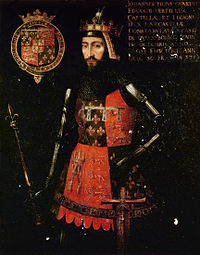
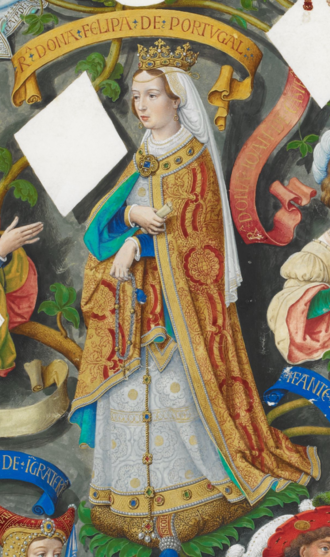
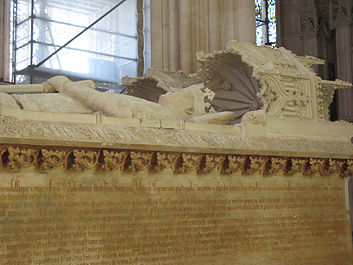


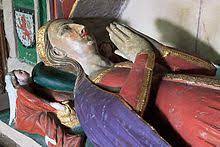



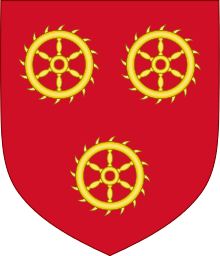
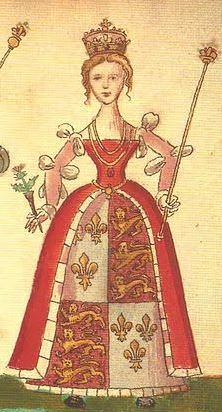



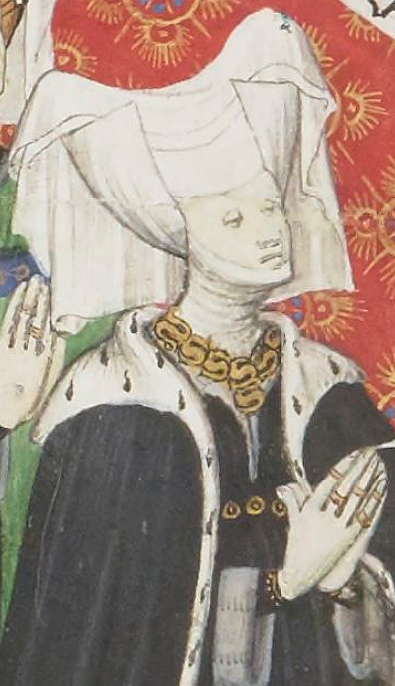

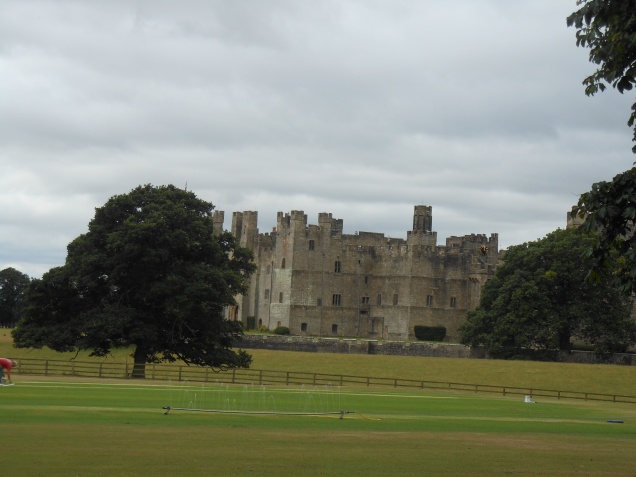
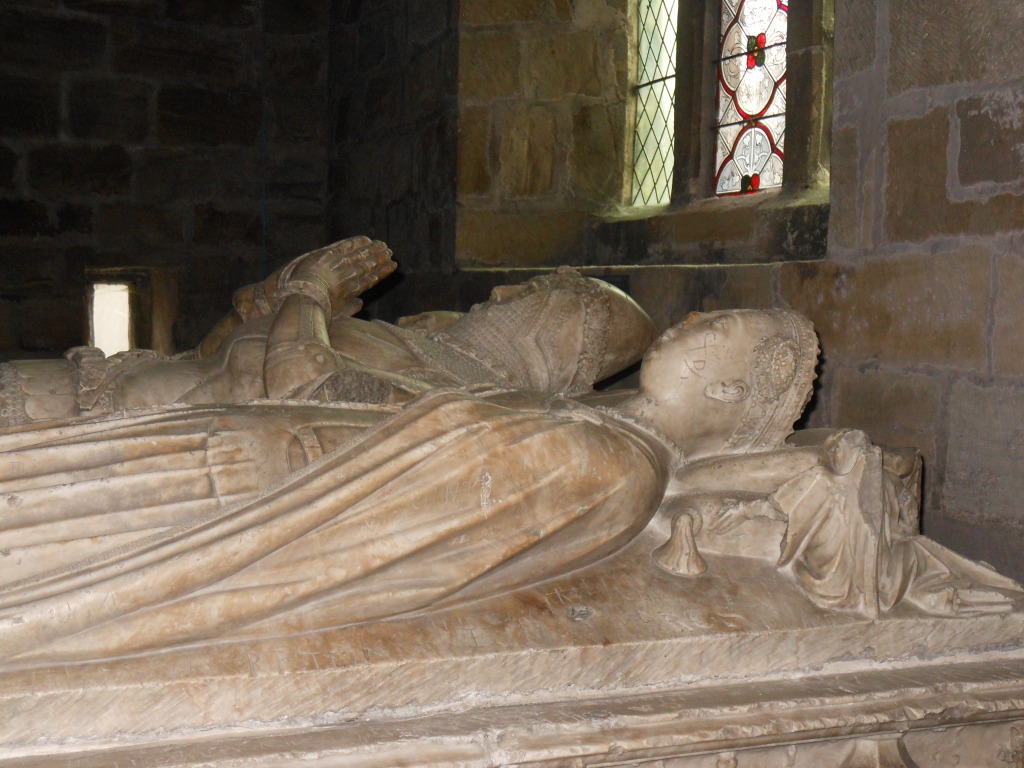
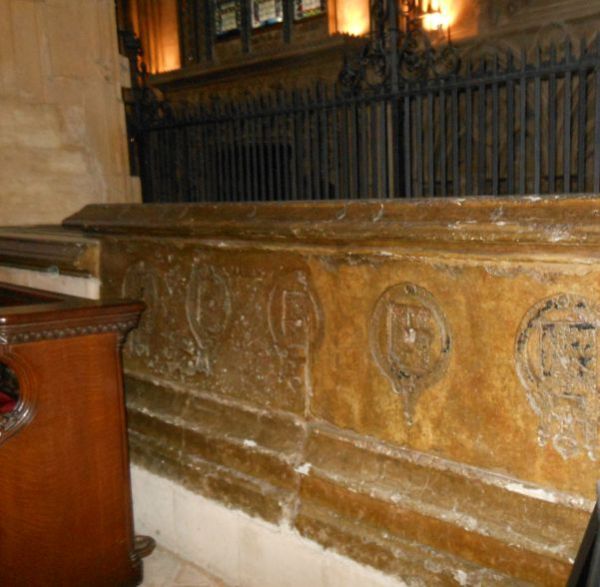









 Amy Licence
Amy Licence
